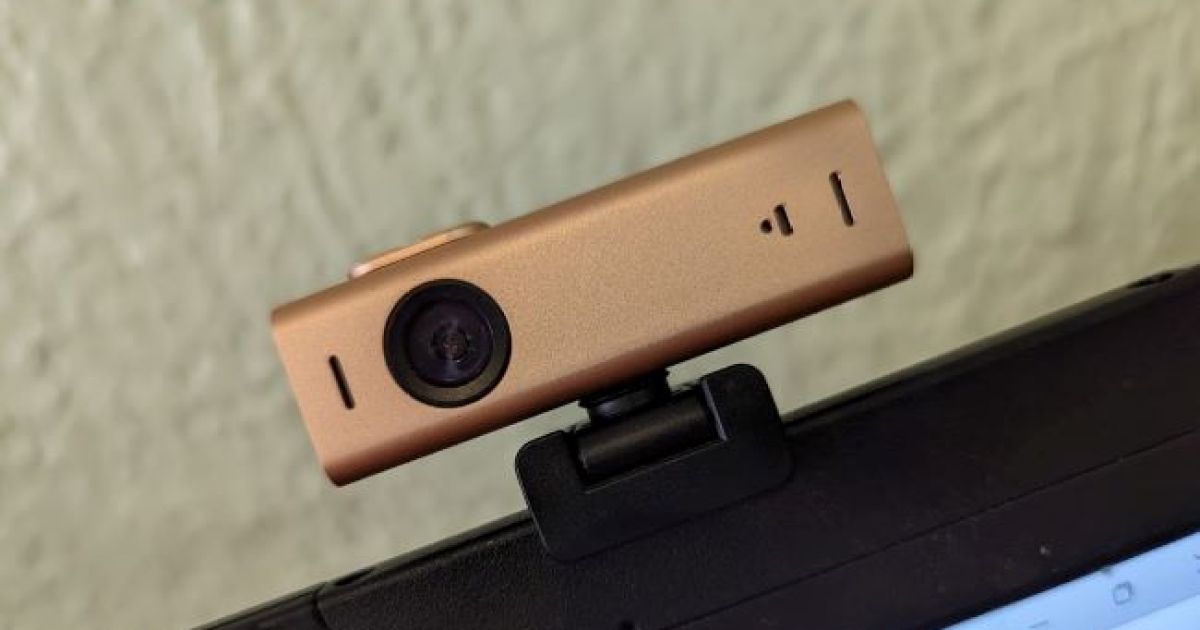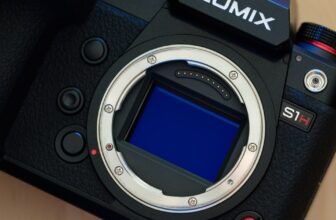
[adinserter block=”1″]
Lumina webcam
MSRP $199.00
“The Lumina webcam is a stylish and compact webcam with great 4K image quality.”
Pros
- Nice design and color options
- Small and lightweight
- Crisp, well-balanced image quality
- Easy setup
Cons
- Accompanying app still in beta
- Important Mac apps aren’t fully compatible
The Lumina webcam is a quirky and stylishly designed webcam with AI-powered features intended to bring a DSLR experience to the home or office.
While many built-in computer web cameras are infamous for being grainy and dark, the Lumina excels in heightening web camera 4K quality, even at its most basic settings.
At $250 (currently $200), it’s quite expensive, and some of the bonus features feel half-baked. But this little webcam just might have the polish and image quality to make up for it.
Design

Amazon and other online retailers are flooded with webcams, but many of them look quite similar. Bulky and ugly are the name of the game.
But the Lumina webcam breaks the mold. This compact and beautiful device would pair perfectly with a MacBook or modern Windows laptop. That’s especially true of the rose gold model I reviewed, which really stands out from the standard dull webcams you can buy. Other color options include silver, atomic gray, and gold.
The matte finish has just enough shimmer to it, and the two “Lumina” logos on each side don’t get in the way. Then there’s the lens, on the left side, the power lighting, and the speakers on either side.
The Lumina’s design is overall minimalistic at 3.5 ounces (100 grams) and 22 x 22 x 70 millimeters. It has a compact, curved rectangular shape and is made of aerospace-grade aluminum. Its black computer mount blended in well with my all-black rugged laptop. You can easily swap the accessory out for a tripod mount, but that feature is not included.
The accompanying cord is USB-C, but the webcam also supports USB 2.0. Functionality is definitely ideal when the webcam is plugged directly into your machine. I happen to have a USB hub and wireless mouse that take up much of my limited I/O space, so there was a lot of plugging in and out required to use this device. For me, it wasn’t too much of a hassle, but it’s something to keep in mind if you’ll be using your webcam frequently. Either be prepared to have a dedicated port for your Lumina or to unplug other devices to make room for your webcam.

The Lumina comes with a magnetic snap-on privacy cover that matches the look of the body and is intended to be snapped back to the rear when not in use and snapped forward over the lens to hide the camera when needed. That makes it fairly unobtrusive, but I consider it an accessory that can still be misplaced if not properly handled.
The Lumina also includes a color card with a QR code on it in the box. The idea? You buy a Lumina webcam and then get on an onboarding call to have an official rep walk you through tuning and calibrating your camera. That doesn’t sound all that helpful, and it wasn’t currently available anyways.
Features
The Lumina camera features a 4K 5 element f/2.0 glass lens with a 24.84mm² sensor and a field of view customizable between 65 degrees and 95 degrees. Some of the features highlighted by Lumina include active color calibration and “adjustable AI cameraman.”
Many of these features are accessible in the Lumina app; however, as I said, the active color calibration was one I was not able to test. Typically, you would hold the color card up in the app’s preview window to have it automatically adjust for aspects such as skin tone, lighting, texture, etc., to make for an ideal video shot.

The AI cameraman includes some configurations in advanced settings that control the AI tracking feature on the Lumina webcam. The options include zoom, speed, offset x, and offset y. Another interesting advanced feature is curve lift, which really effectively brings out details in highly textured hair.

There are two camera settings available for use, the Lumina Raw and Lumina Plus. The Lumina Plus camera requires a product key to unlock during software installation, but once it’s accessible, you can switch between the two cameras, in addition to your standard computer camera, at will. The Lumina Plus camera is the full-featured setting, which gives you access to image enhancements, zoom, and much more.
The Lumina Raw setting is just how it sounds. The lens itself and no more. The addition of the Raw setting is nice, especially when you’re trying to get a grip on how good this camera really is, outside of any software touch-ups and optimizations.
You can also toy around with the Lumina app settings privately, using the retractable open preview option or while live on a video chat in the app of your choosing.
App compatibility
While the Lumina webcam is supports both Windows and Mac, there is a lot of varied app compatibility between the two cameras and the two operating systems.
For example, the list of apps that the Lumina Raw camera is compatible with include Zoom, Google Meet, OBS, Webex by Cisco, Skype, Discord, Microsoft Teams, Slack, FaceTime, QuickTime Player, Photo Booth, iMovie, Ecamm Live, mmhmm, Loom, Riverside.fm, WhatsApp, BlueJeans, and StreamYard. That’s a solid amount of apps, and those are all available for both Mac and Windows.
Unfortunately, when it comes to Lumina Plus, things get far more messy. The Lumina Plus camera for Mac is compatible with Zoom, Google Meet, OBS, Cisco Webex, Skype, Ecamm Live, mmhmm, Riverside.fm, BlueJeans, and StreamYard. There are some notable holes here, including Teams, Discord, Slack, and FaceTime.
Lumina Plus has better compatibility for Windows apps, but as it currently stands, it’s missing far too many important apps on the Mac side.
Video quality
Despite the nuances between the camera settings and operating systems, video quality is where the Lumina webcam shines. I tested the webcam connected to a Panasonic Toughbook Windows laptop. Despite being just HD resolution, it has solid image quality for an internal webcam of its kind.
However, once I began testing the Lumina webcam, I truly began to see the differences. I especially noted the halo effect I got from my ring light, which is apparent in the image on my HD web camera.
With the Lumina webcam, my screenshots are a lot more consistent, no matter how I switched the camera from Raw to Plus or tweaked the settings. Below, I’ve included an image where I’ve set the zoom and blur, and another where I’ve toyed with the blue and red lighting, as well as the saturation, and there is no indication of my having additional lighting in the background.

Similar to a DSLR camera, the Lumina Raw camera has the most basic settings, while the Lumina Plus camera has a few tweaks already added to make for typical ideal settings without calibration. Either way, the Lumina webcam performed at a high level of quality and left me thoroughly impressed.

During my consultation, I was recommended some tweaks to hue and saturation, in addition to the curve lift feature, in lieu of the AI calibration, to highlight my skin tone and hair texture.
With some tweaking, I was able to get a really clear and complimentary image. Don’t get me wrong — right out of the box, the Lumina camera looks great. But with some time, you can really take the imaging to another level that is customized well for your particular face.
Our take
The Lumina camera is going in the direction of many gadgets, blending high-tech features with a sleek and stylish design. It’s great that the camera quality stands out well, even before considering the app. Often, such features can become forgotten by those who are not enthusiasts. However, taking advantage of all of the settings and services Lumina offers with its webcam can only elevate the user experience.
Are there any alternatives?
The Logitech Brio would be a decent alternative as a 4K webcam that is highly regarded and well-reviewed in the industry. It is similarly priced at $200; however, it has been on the market long enough that it is starting to see discounts. The Logitech C920x Pro HD webcam is not
How long will it last?
The Lumina webcam comes with a 14-day observation period, in which it can be exchanged or returned, and also has a one-year warranty, under which the brand will assist with mishaps within reason. Its aluminum build should be durable enough to withstand a long life of several years. One plus of its beta status is that developers are consistently working on the software and striving for feedback. Users are encouraged to reach out.
Should I buy it?
At $250, the Lumina webcam is definitely a splurge. The webcam is currently being marketed at a sale price of $199, but there is no telling how long the sale will extend.
I say buy it if you have a solid purpose, such as consistent streaming, or a remote job that requires you on your absolute A game all of the time. The video quality alone is enough to say yes, but only as long as the price remains in step with the competition.
Editors’ Recommendations
[adinserter block=”1″]
Credit : Source Post






